Two key aspects of the weather influence the time to complete a Strava segment: the wind and the air density. This blog considers the direction and speed of the wind. The following blog will examine how aerodynamic drag is affected by changes in air density.
Clearly, on an exposed, arrow-straight segment, the most favourable weather would be a hurricane tailwind. Like other KOM hunters, I have searched for segments that align with the predicted wind direction when a gale is forecast, though I’ve usually ended up going kitesurfing instead.
When the segment is a loop, such as the Tour de Richmond Park, discussed in the previous blog, the question becomes more interesting. Consider a light aircraft flying above the Richmond Park segment at an altitude of 300m. Any constant wind, regardless of direction, will result in a slower time than completing the circuit in still air. Why? Since any headwind slows down the plane, it hinders the pilot for more time than the tailwind provides assistance, resulting in a net increase in the total time.
However, cyclists do not ride in constant winds. Trees, buildings and the terrain all affect the wind’s speed and direction. Variability is so strong that it is recommended that multiple anemometers should be positioned at intervals alongside the 100m track at important athletics meetings.
All this means that it is quite likely that there are optimal wind conditions for all Strava segments. Most people suggest that a tailwind up Sawyers Hill is best for Richmond Park, as this part of the segment is an uphill drag that is exposed to the wind, whereas other sections of the route are much more sheltered. The bearing of a tailwind would be from just North of Easterly. Historically, this is not a very common wind direction for London. The following charts shows the prevailing wind direction over the year is Southwesterly.
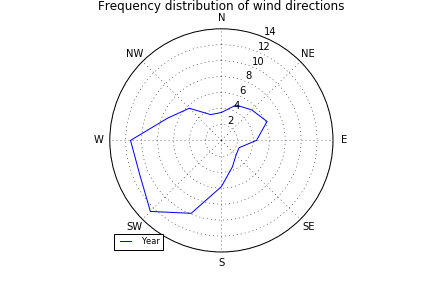
Easterly winds are even rarer in July and August, when many PBs have been set, though in September they have been a little more frequent. (An interactive version of the chart can be found on this site.)
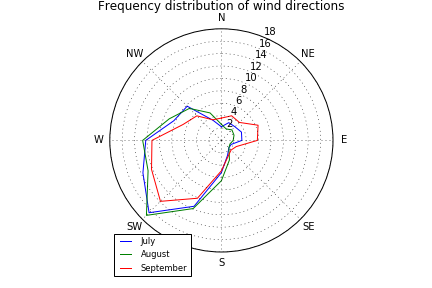
Now, if the wind had no effect on the Strava segment, we would expect the distribution of wind directions on which riders set their PBs to be similar to the historic distribution. So we are interested in the difference between the distribution of wind directions on the dates derived from the leaderboard relative the background average. The following chart compares the segment against the historic average annual average. The compass rose clearly shows a much higher frequency (13%) of the PBs of the top 1000 riders were set when the wind was blowing from the East and a relatively lower incidence in the opposite direction.
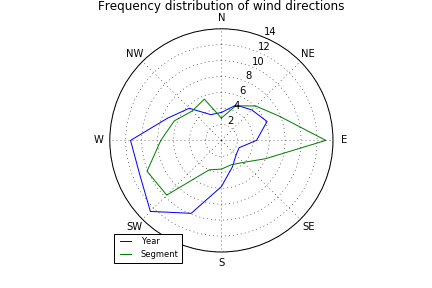
The next hand chart “unwraps” the two curves to show the relative difference, which is statistically highly significant (p<0.01). A forensic analysis of the data confirms that the best wind direction for a PB around Richmond Park is indeed an Easterly tailwind up Sawyers Hill.
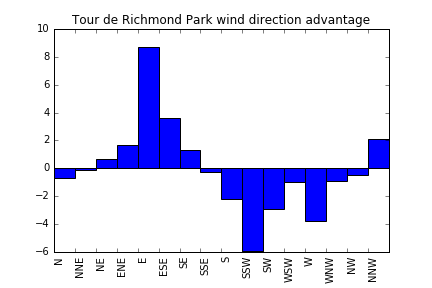
So far we have not considered the strength of the wind. The next chart shows the average windspeed on the days that PBs were set, according to the direction of the wind. This shows a bias towards stronger winds from the East, consistent with the frequency of PBs.
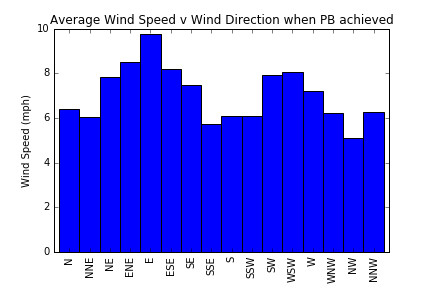
Combining this with the results of the previous blog, the following conclusions may be drawn. However good a cyclist you are, your best chance of achieving a high ranking on the Tour de Richmond Park leaderboard is to choose the evening or morning of one of the rare summer days when the wind is blowing strongly from the East. And, you guessed it, on the evening of August 2015 when Rob Sharland achieved his KOM, the wind was blowing at 11mph on a bearing of 80° .
The next blog will examine how temperature, pressure and humidity, as well as altitude, change the air’s density. This is the principal environmental factor affecting your aerodynamic drag, when you are going for a KOM.


Love this in-depth analysis!!! 🙂
LikeLike
Wow! I arrived at a very similar conclusion based on way too many of my own laps of RP.
I’m assuming you are assuming anticlockwise for the strong easterly conclusion – I’d agree and that is also favoured by sheltering on the east-facing sections, as you know.
that particular segment/lap starting at Roehampton also lets lesser cyclists do the hard bit whilst they are still a bit fresher.
for a CLOCKWISE lap, my conclusion was that starting at the Ham Gate junction was the best for a southerly wind (but that was because that was where i often started). in reality kingston gate for a clockwise with southerly is probably best.
LikeLike
Thank you for beiing you
LikeLike